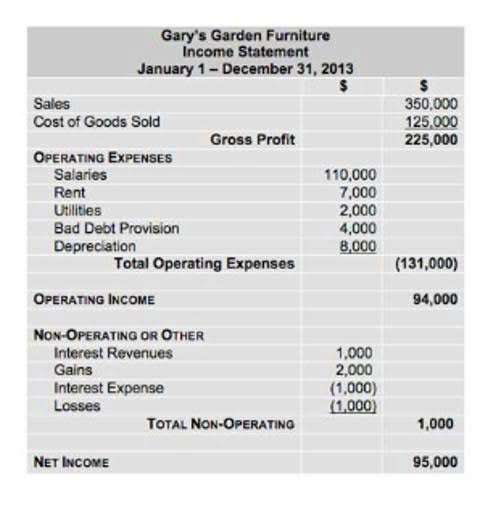
It’s important to note that retained earnings are cumulative, meaning the ending retained earnings balance for one accounting period becomes the beginning retained earnings balance for the next period. When a company consistently experiences net losses, those losses deplete its retained earnings. Prolonged periods of declining sales, increased expenses, or unsuccessful business ventures can lead to negative retained earnings. Additional paid-in capital is the value of unearned revenue a stock above its face value, and this additional value does not impact retained earnings. However, this form of capital reflects higher available equity that may generate higher long-term revenues and, indirectly, increased retained earnings.

What’s the point of carrying forward positive results?
In a budget, retained earnings are the amount of income after expenses (or net income) that a company has held onto over the years. This reduction happens because dividends are considered a distribution of profits that no longer remain with the company. Below is the balance sheet for Bank of America Corporation (BAC) for the fiscal year ending in 2020. In addition to internal factors, external events such as economic shifts, regulatory changes, or market trends can also influence retained earnings. Companies must adapt their strategies in response to these external pressures to maintain a healthy level of retained earnings. For example, a change in consumer behavior might necessitate increased marketing spend, affecting both net income and retained earnings.
Unit 14: Stockholders’ Equity, Earnings and Dividends
The decision to retain earnings or distribute them as dividends falls to the board of directors and is influenced by the corporation’s growth strategy, dividend policy, and the expectations of shareholders. Retained earnings in corporations are also subject to regulations and corporate governance, which can dictate the level of profits that must be retained for legal or policy reasons. The retained earnings for a corporation are a reflection of its ability to generate profits and its strategic decisions regarding reinvestment and dividend distribution. In conclusion, Retained Earnings is a critical component of a company’s financial statements.

Management and Retained Earnings

If a company’s earnings are negative, the company has incurred losses from its operations. This is because they were able to cover their cost of goods sold and other operational expenses, pay dividends and still have some amount leftover that can be referred to as retained earnings. To understand why retained earnings is a credit, it’s essential to contrast it with dividends. Dividends are a distribution of profits to shareholders, which reduces the company’s retained earnings.
- For example, a strong retained earnings track record can attract investment capital or potential buyers if you intend to sell your business.
- Retained Earnings represents the company’s ability to generate profits and retain them within the business.
- Available retained earnings can be reinvested back into the company by paying off debts and distributing profits to its owners and shareholders.
- This amount is usually held in a reserve by the company and could be used to increase the company’s asset base or reduce some of its liabilities.
- Retained Earnings are a part of “Shareholders Equity” presented on the “Liabilities side” of the balance sheet as it indicates the company’s liability to the owners or shareholders.
- Paying off high-interest debt also may be preferred by both management and shareholders, instead of dividend payments.
Retained Earnings are credited with the Net Profit earned during the current period. Retained Earnings are a part of “Shareholders Equity” presented on the “Liabilities side” of the balance sheet as it indicates the company’s liability to the owners or shareholders. If for instance, the company incurred losses of $100,000 the journal entry for the loss will be recorded as shown below. In order for us to effectively answer the question of retained earnings being debit or credit, we first have to understand what retained earnings are and further take a look at Bookkeeping for Chiropractors the meaning of debit and credit.
Once retained earnings hit a certain limit, the excess amount can be taxed unless the corporation can justify the accumulation. It involves paying out a nominal amount of dividends and retaining a good portion of the earnings, which offers a win-win. When a company consistently retains part of its earnings and demonstrates a history of profitability, it’s a good indicator of financial health and growth potential. This can make a business more appealing to investors who are seeking long-term value and a return on their investment. Yes, having high retained earnings is considered a positive sign for a company’s financial performance. Most software offers ready-made report templates, including a statement of retained earnings, which you can customize to fit your company’s needs.

Where Is Retained Earnings on a Balance Sheet?
If a company decides not to pay dividends, and instead keeps all of its profits for internal use, then the retained earnings balance increases by the full amount of net income, also called net profit. When distributions are declared by a company, the amount that will be paid as dividends to its shareholder is usually taken out of its retained earnings account on the date of the declaration. Hence if a company declares $8,950 in dividends to its shareholders on October 28, 2022, the journal entry to record this dividend payment will be as the one below. Recording transactions into journal entries is easier when you focus on the equal sign in the accounting equation. Assets, which are on the left of the equal sign, increase on the left side or DEBIT side.

Cash Inflows & Outflows of Operations
Revenue, net profit, and retained earnings are terms frequently used on a company’s balance sheet, but it’s important to understand their differences. The useful lifespan of an asset is the time it will take from its purchase to when it will no longer be efficient. The cost of the asset is then spread over the useful lifespan of the assets and accounted for as depreciation. When the depreciation account balance is high, it decreases the amount that will be left over as retained earnings.
What is the Normal Balance in the Retained Earnings Account?
- Changes in appropriated retained earnings consist of increases or decreases in appropriations.
- Profits give a lot of room to the business owner(s) or the company management to use the surplus money earned.
- According to FASB Statement No. 16, prior period adjustments consist almost entirely of corrections of errors in previously published financial statements.
- Retained earnings are part of a company’s equity account and a debit to this account decreases the balance while a credit increases it.
- Typically you would not change the amount recorded in your retained earnings unless you are adjusting a previous accounting error.
- A corporate balance sheet includes a shareholders’ equity section, which documents the company’s retained earnings.
When companies keep a record of their transactions, they do so using the double-entry bookkeeping system. With this system, every transaction has at least two entries made for it with one being debit and another being credit. Debits are usually retained earnings is debit or credit placed on the left side of the accounting entry while credits are placed on the right-hand side. Managing retained earnings depends on many factors, including management’s plans for the business, shareholder expectations, the business stage and expectations about future market conditions. For example, a strong retained earnings track record can attract investment capital or potential buyers if you intend to sell your business.
No comment yet, add your voice below!